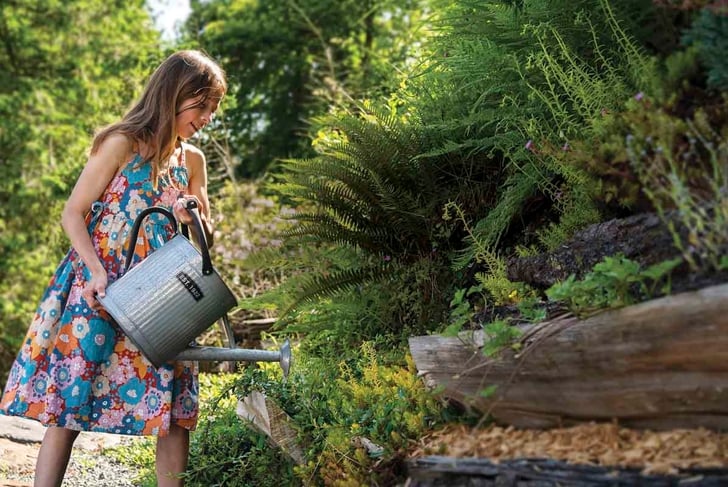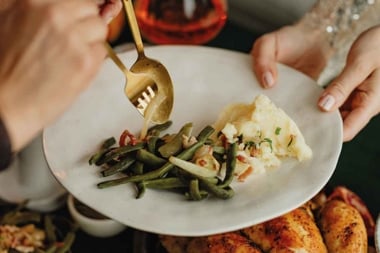
Kids: meet the plants, our oldest sources of medicine. Plants: meet the kids, our littlest humans—voracious learners who occasionally suffer from coughs, stomach aches, and racing minds that keep them up at night. May the two of you have a long and happy friendship.
Changing with the times
In the 50 years since alive’s “The Herbs and I” article was published, our understanding of what is and isn’t safe for kids has evolved substantially.
Experts now advise against the use of comfrey for children either internally or externally, and astute readers will notice we’ve upped the safe honey consumption age. What has stood the test of time, though, is our enthusiasm for connecting with the medicinal power of plants.
Gentle helpers
We needn’t be herbalists to safely introduce our young ones to the medicinal potential of plants, kindling a lifelong interest in herbs as natural allies in their well-being. Derek Fleming, master herbalist and owner of New Earth Organics, recommends culinary herbs as the best entry point for this early education.
While adults sometimes require more potent remedies, “kids respond really well to gentle things,” Fleming says. And he finds the surest way to children’s herbal hearts is through their senses.
Start at the source
Sure, effective herbs can be bought at the store, but sensory learning really begins when kids grow or gather the plants themselves. In the yard or a window box, culinary herbs, like oregano and peppermint, give off tell-tale aromas when rubbed between their little thumbs and fingers.
Children will be proud to create the garden markers or snip the right species for tea or a savoury dish. Fleming suggests reinforcing this hands-on experience with sensory descriptors like “spicy” or “aromatic” that suit the herbs and hint at their therapeutic properties.
Wild foraging is another way to collect medicinal plant material, but must be restricted to species we can identify with absolute certainty. If you know your yarrow, its magic ability to stop the bleeding on a youngster’s scraped knee would make quite an impression. Still, we have to remember that many herbs considered beneficial for adults aren’t recommended for children―another reason Fleming likes to stick to the gentle effectiveness of kitchen herbs.
Not too much
Although there is no regulated dosage formula for herbs, typical herbal dosage is based on a 150 lb (68 kg) adult, so a child’s dosage can be determined accordingly―for example, at 1/3 the weight, a 50 lb (23 kg) child would take a 1/3 dose.
Tea time
With herbs on hand, how do we turn them into medicine that kids will actually consume? The potency of a tincture isn’t likely to win over young taste buds, but teas and honeys might.
Children can crush, tear, or chop the plant material, committing the look, feel, and smell to memory. With his own kids, Fleming turns tea-making into a visual delight by using a glass pot through which they can watch the herbs release their essence and flavour.
Chamomile is a favourite, both for its relaxing qualities and because it pairs well with milk or cream, creating a bloom of white when added to the transparent vessel.
So sweet
Honey also makes an excellent vehicle for medicine. Kids can help fill a jar with antimicrobial and immune-boosting garlic cloves, then cover them with honey and wait for the whole thing to transform into a medicinal syrup with “candied” cloves. Fleming likes to infuse honey with fennel and thyme to have on hand as a cough remedy. (A note here that honey is not recommended for children younger than one year.)
Just like the grownups
Children learn by example and sometimes want to emulate the adult morning coffee ritual. Fleming takes this as the perfect opportunity to introduce them to dandelion root with its bitter flavour―a clue to its medicinal power. Kids can participate in digging the roots, even chopping and roasting them, then enjoy the resulting “kid coffee” brew (made a little sweet and creamy, to suit).
Expert help
To make kids’ herbal education both fun and accurate, we can lean on trusted resources. Here are some suggestions:
- flashcards, board games, and children’s book series at learningherbs.com
- A Kids Herb Book by Lesley Tierra (Robert Reed Publishers, 2018)
- Super Cool Kids Book by Mountain Rose Herbs (2022)
- Herbs for Children’s Health by Rosemary Gladstar (Storey Publishing, LLC, 2015)
I recognize you!
Once our children have developed a sensory familiarity with certain plants, we can translate that into new contexts. Fleming calls this “bridging”―if he rubs Roman chamomile essential oil (one drop in a carrier oil) on his kids’ feet before bed, they’ll recognize the scent and its calming effects from their garden and tea experience.
Having tasted fennel previously and learned how that licorice-y flavour translates to cough suppression, it will make perfect sense to take it as a tea or honey when they have a cold. For skin irritations, we can dab on a tea made from their astringent friend, the raspberry leaf.
Four seasons
Your little ones can access dried or otherwise-preserved summer herbs year-round, or they can stretch the season by having an indoor windowsill garden. Plus, many plants can still be identified in their dormant state or by their dead stalks over the winter.
Fleming especially likes finding wild bergamot this way, crumbling the dry seed heads so his kids can smell the aromatic carvacrol (the compound we associate with oil of oregano). Just see what your herbal explorations naturally uncover!
Kid-friendly medicinal herbs
These familiar culinary herbs can double as safe and gentle kids’ medicine:
|
Herb |
Potential benefits |
Suggested use |
|
lavender |
calming, antimicrobial |
essential oil in a diffuser, part of a tea blend |
|
peppermint |
aids with digestion, nausea, and congestion |
tea, essential oil in a diffuser (not for kids under 30 months) |
|
fennel |
may help soothe gastrointestinal upset and cough |
tea―seeds or leaves (use caution in infants) |
|
thyme |
cough suppression |
tea, honey, or prepared cough remedy |
|
chamomile |
calming, aids sleep |
tea, diluted essential oil (topical) |
|
rosemary |
may enhance working memory (schoolwork, etc.) |
essential oil in a diffuser |
This article was originally published in the August 2025 issue of alive magazine.





